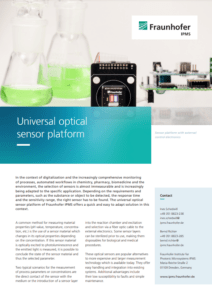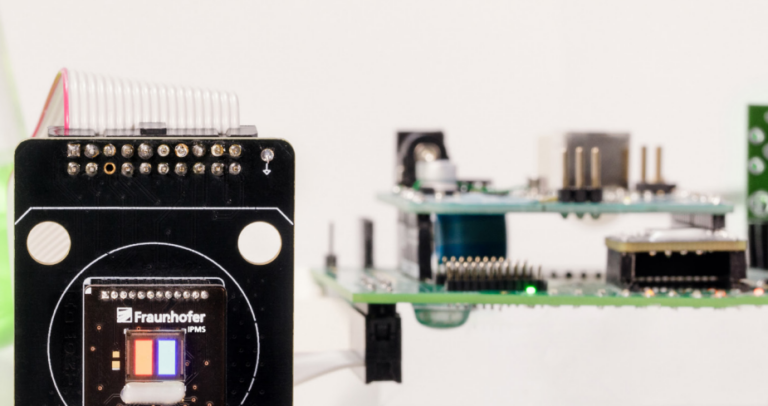In the context of digitalization and the increasingly comprehensive monitoring of processes, automated workflows in chemistry, pharmacy, biomedicine and the environment, the selection of sensors is almost immeasurable and is increasingly being adapted to the specific application. Depending on the requirements and parameters, such as the substance or object to be detected, the response time and the sensitivity range, the right sensor has to be found. The universal optical sensor platform of Fraunhofer IPMS offers a quick and easy to adapt solution in this context.
A common method for measuring material properties (pH value, temperature, concentration, etc.) is the use of a sensor material which changes in its optical properties depending on the concentration. If this sensor material is optically excited to photoluminescence and the emitted light is measured, it is possible to conclude the state of the sensor material and thus the selected parameter.
Two typical scenarios for the measurement of process parameters or concentrations are the direct contact of the sensor with the medium or the introduction of a sensor layer into the reaction chamber and excitation and selection via a fiber optic cable to the external electronics. Some sensor layers can be sterilized prior to use, making them disposables for biological and medical procedures.
These optical sensors are popular alternatives to more expensive and larger measuremen technology which is available today. They offer easy handling and integration into existing systems. Additional advantages include their low susceptibility to faults and simple maintenance.
Technical data
Fraunhofer IPMS has extensive know-how in the development of organic electronics in combination with CMOS design, user software and electrical control.
Using organic light emitting diodes and a specially developed CMOS backplane design, a sensor platform for optical excitation and selection of sensor layers was realized. There are two OLED dots as well as photodiodes and the control and readout electronics for emission and detection of light on the chips. The emission wavelength of the light emitting diodes can be adjusted in the visible and adjacent spectral range and thus enables the excitation of different sensor materials for different parameter measurements. By integrating color filters with adapted characteristics depending on the dye in the sensor layer, the sensor chip can be designed for a wide range of applications and combinations with sensor materials and is therefore versatile.
Customer-specific sensor platform
The sensor chip has three large photodiode fields, each of which is covered by color filters. The optical properties of the color filters can be designed according to the application. The sensor layer determines the necessary spectral properties of the color filters and the OLED emission wavelength. For example, the dyes used to detect the pH value and the oxygen concentration have different excitation wavelengths and therefore different emission wavelengths. The color filters and excitation-OLED of the sensor are adapted to the dye and are therefore highly compatible with the large number of sensor layers of commercial manufacturers.
This sensor platform is versatile and can also be used without the phosphorescent sensor layers to evaluate single or multicolor periodic light signals over time. The integrated photodiodes and variable filter characteristics allow a wide range of applications for electro-optical measurements.




